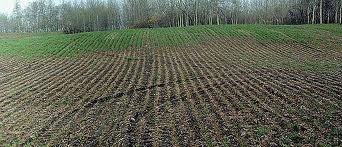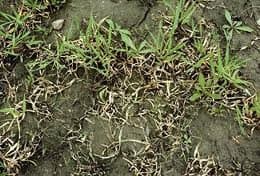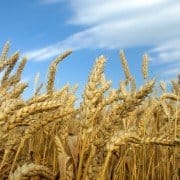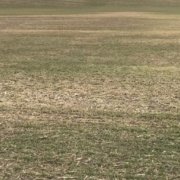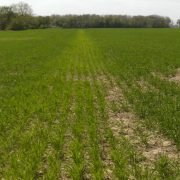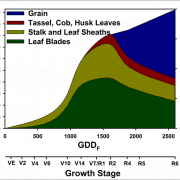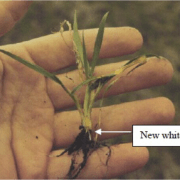Snow mould in winter cereals
Holly Loucas, Agronomist, DOW Agroscience
What is snow mould?
Snow moulds are cold-loving fungi that can attack many economic plants under a cover of snow.
Pathogen biology
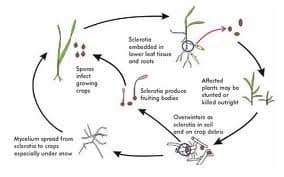 The important species of snow moulds that infect winter wheat are Microdochium nivale and Typhla spp.
The important species of snow moulds that infect winter wheat are Microdochium nivale and Typhla spp.
Gray snow mould (Typhula spp) is the less damaging form of snow mould. It is able to survive throughout hot summer months as sclerotia under the ground or in plant debris.
Pink snow mould (Microdochium nivale) is usually more severe than gray snow mould. It can survive the summer months in decayed plant debris as spores or mycelium.
Snow moulds grow under the cover of snow where the dark, humid conditions favour its development. Snow moulds are able to grow at 0C and below and have a maximal growth rate at about 20C. They infect snow-covered plants when the temperature at the snow-plant interface remains around 0C, usually in late fall or early winter when the soil is not yet frozen. The fungus grows and spreads in the plant tissue during the long winter (November through early March). Snow mould fungi become inactive when soil temperatures fall below -5C. Peak snow mould activity on plants occurs during spring break-up when the soil temperatures are around freezing and the soil-snow interface is satu-rated with melting snow.
The dark, humid and relatively mild environment provided by the snow cover prevents photosynthesis and drastically reduces plant metabolism. The developing wheat plant has no choice but to use its stored carbohydrates and proteins to survive. The result is a stressed plant that is more susceptible to diseases, especially snow moulds.
Snow mould tolerant cultivars tend to metabolize carbohydrates more slowly, which results in healthier plants which are less suscep-tible to fungal attack.
Effect on plants
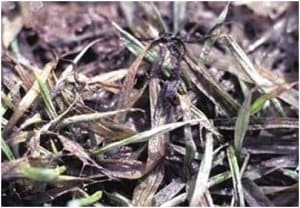 Snow mould damage is usually evident as soon as the snow melts in the spring. The presence of mycelia (masses of fibrous strands of fungus), the occurrence, colour and size of sclerotia or spores, and plant discolouration in the early spring provide the best clues for field identification.
Snow mould damage is usually evident as soon as the snow melts in the spring. The presence of mycelia (masses of fibrous strands of fungus), the occurrence, colour and size of sclerotia or spores, and plant discolouration in the early spring provide the best clues for field identification.
Individual plants, groups of plants or large areas can be affected. The most obvious symptom is dead plants that are slimy, brown and rotted.
Conditions favouring disease
Snow mould damage is usually evident as soon as the snow melts in the spring. The presence of mycelia (masses of fibrous strands of fungus), the occurrence, colour and size of sclerotia or spores, and plant discolouration in the early spring provide the best clues for field identification. Severity of snow mould damage increases in years when an early snow cover in the fall (mid-Nov) persists until late March or April.
Early planted wheat is usually more affected, since lush ‘top-growth’ promotes infection and aids in disease spread from plant to plant. Plants that have one or many leaves with necrosis (ie:brown tips) may have healthy crowns and will recover with little or no impact on yield. Symptoms are most pronounced in areas of the field that had heavy snow cover, such as field borders, headlands and down slopes of hills.
Warm, dry weather in the spring will stop disease development and promote rapid plant growth.
Management
- Early planted wheat is at a higher risk. It is recommended to reduce seeding rate when planting winter wheat early. Snow mould is significantly worse in fields with high seeding rates, especially on fertile soil, where there is plenty of lush, top-growth. OMAFRA recommended seeding rates for early planting on all soils, except clay, is 1.2 million seeds/ac. On clay soils, it is more important to get a good stand establishment, so the recommendation is to use 1.5 million seeds/ac regardless of planting date.
- Seed treatment is reported to have increased control of snow mould.
- No winter wheat cultivar is resistant to snow moulds, however, cultivars differ in tolerance.
- Inoculum of some species of snow mould can build up quickly. There is a greater risk of damage in rotations that include a high frequency of winter cereals or where winter cereals follow grass or legume forages.
- Direct (no-till) seading of winter cereal into standing stubble of a previous crop has proven to be an effective method of avoiding damage.
- Snow mould does not affect spring planted grain or soybeans if a replant is needed
Fig 1. Snow mould damage to winter wheat. Note the green healthy stand at the top of the hill and the extensive snow mould damage on the hillside where the snow banked during the winter. (University of Saskatchewan).
Fig 2. Close-up of snow mould damage in winter wheat. (University of Saskatchewan).
References:
University of Saskatchewan.
McBeath, J.H. 2002. Snow mold-plant antagonist interactions:survival of the fittest under the snow. The Plant Health Instructor. University of Alaska Fairbanks.
Peter Johnson, Crop Advances:Field Cropo Reports—Seeding Rates for Early Planted Wheat.
OMAFRA. http://www.omafra.gov.on.ca/english/crops/pub811/14cereal.htm


